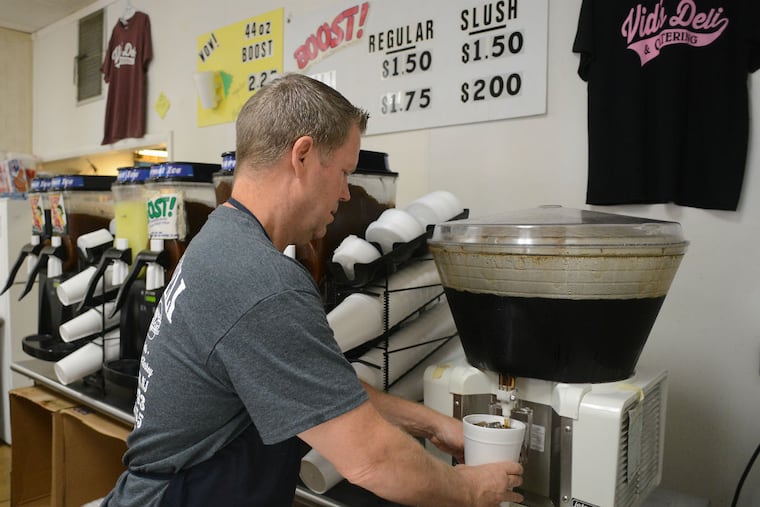A flat, thick, weird-tasting soda you'll only find in Jersey: 'This is our crack'
It's not technically a soft drink, and it's hard to find outside a handful of towns in Burlington County. But it's a staple of the South Jersey river communities.

Double-fisting a syrupy drink outside Vid's deli in South Jersey on Thursday morning, retired mail carrier Tim LeConey and a fellow Riverside native recounted their introductions to BOOST! like aging sailors reminiscing about their first sights of the sea.
"It was in my bottle," LeConey said.
Riverside Township Mayor George Conard added: "Yeah, it's called milk-BOOST! I used to put a little bit of BOOST! syrup in my kid's milk bottle."
Some people call it a soda, but it's not technically a soft drink. It's hard to find outside a handful of towns in Burlington County, but it's a staple of the river communities, with a quick shot of syrup believed to be an instant cure for upset stomachs and finicky babies.
"Because the guy who invented it," LeConey said, "was a pharmacist."
Despite its longevity and local popularity, this flat, thick, weird beverage has never caught on beyond its South Jersey roots.
A name that stuck
BOOST! was born in a Riverside pharmacy around 1910, when pharmacist Benjamin Faunce reportedly set out to create a soft drink without bubbles.
The result was a syrup that, once mixed with plain water, creates a caramel-colored drink with a strong, sappy, citrus flavor. He called it "TAKABOOST." The original version has 32 grams of sugar and plenty of caffeine in an 8-ounce container.
The name has gone through several iterations. After Faunce died in 1949, family members argued over the direction the Tak-A-Boost company was taking. One faction split off and formed the rival Drink-Atoast Co., which created and sold a similar product. Tak-A-Boost sued Drink-Atoast over formulas, lost, and went bankrupt in 1957. Drink-Atoast then scooped up the trademarks and used the formulas.
In 1985, the name of the beverage was changed back to BOOST!
"Everyone called it that anyhow," the company's former president, Charles Dugan, said in 1995. "Besides, BOOST! was a more energetic, marketable name."
In the mid-'90s, when nutrition-product giant Mead Johnson attempted to sell its sleek new diet drink of the same name in the eight-county South Jersey area, BOOST! struck back. It won a temporary restraining order claiming the drink infringed on their trademarks on its home turf. Mead paid a $350,000 settlement in 1996 and stopped shipment to South Jersey.
In 1997, Drink-Atoast officially became the BOOST! Co.
Got to have it
When LeConey landed with family last week in Riverside, fleeing Hurricane Irma from his retirement home in Florida, his first stop was Vid's to get himself a BOOST!
"When I go in there I say, 'Give me a large crack,' " LeConey said. "Because this is our crack."
Mario Scott, who grew up in Northeast Philadelphia but now lives in Delran, Burlington County, bought the deli in 2012.
"Sometimes, people come in three times a day," Scott said. "Some people actually drink it for hangovers."
Retailers usually mix the syrup with noncarbonated water and ice, and dispense it from large coolers or slushy machines. Consumers can also buy growlers of the syrup and mix it at home. In recent years, a decaffeinated version was developed, and new flavors have been added, including blueberry, watermelon, pink lemonade, green apple, cherry, and mango, popular with children.
Baby boomers still appreciate the original, and fondly remember ringing their straws with sourdough pretzels for a salty twist.
The retail reach doesn't stray far from the factory — typically from Trenton to Woodbury and as far east as Williamstown. Riverfront towns like Palmyra and Riverside remain the drink's strongholds, with colorful signs in storefront windows proudly proclaiming that the drink can be found inside.
In the mid-'90s, the company sold enough BOOST! to make eight million, eight-ounce glasses of the soft drink a year. Devotees buy it everywhere from wholesale clubs to supermarkets to local delis like Vid's, and even by mail-order — the company ships thousands of gallons a year.
"I'll eventually have it shipped in to Florida," LeConey said. "I don't drink coffee. So first thing in the morning, I got to have my BOOST!"